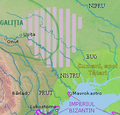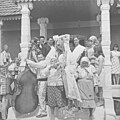Portal:Moldova
The Moldova Portal
Moldova (/mɒlˈdoʊvə/ ⓘ mol-DOH-və, sometimes UK: /ˈmɒldəvə/ MOL-də-və; Romanian pronunciation: [molˈdova]), officially the Republic of Moldova (Romanian: Republica Moldova), is a landlocked country in Eastern Europe, on the northeastern corner of the Balkans. The country spans a total of 33,483 km2 (13,067 sq mi) and has a population of approximately 2.5 million as of January 2023. Moldova is bordered by Romania to the west and Ukraine to the north, east, and south. The unrecognised breakaway state of Transnistria lies across the Dniester river on the country's eastern border with Ukraine. Moldova is a unitary parliamentary representative democratic republic with its capital in Chișinău, the country's largest city and main cultural and commercial centre. Most of Moldovan territory was a part of the Principality of Moldavia from the 14th century until 1812, when it was ceded to the Russian Empire by the Ottoman Empire (to which Moldavia was a vassal state) and became known as Bessarabia. In 1856, southern Bessarabia was returned to Moldavia, which three years later united with Wallachia to form Romania, but Russian rule was restored over the whole of the region in 1878. During the 1917 Russian Revolution, Bessarabia briefly became an autonomous state within the Russian Republic. In February 1918, it declared independence and then integrated into Romania later that year following a vote of its assembly. The decision was disputed by Soviet Russia, which in 1924 established, within the Ukrainian SSR, a so-called Moldavian autonomous republic on partially Moldovan-inhabited territories to the east of Bessarabia. In 1940, as a consequence of the Molotov–Ribbentrop Pact, Romania was compelled to cede Bessarabia and Northern Bukovina to the Soviet Union, leading to the creation of the Moldavian Soviet Socialist Republic (Moldavian SSR). On 27 August 1991, as the dissolution of the Soviet Union was underway, the Moldavian SSR declared independence and took the name Moldova. However, the strip of Moldovan territory on the east bank of the Dniester has been under the de facto control of the breakaway government of Transnistria since 1990. The constitution of Moldova was adopted in 1994, and the country became a parliamentary republic with a president as head of state and a prime minister as head of government. Under the presidency of Maia Sandu, elected in 2020 on a pro-Western and anti-corruption ticket, Moldova has pursued membership of the European Union, and was granted candidate status in June 2022. Accession talks to the EU began on 13 December 2023. Sandu has also suggested an end to Moldova's constitutional commitment to military neutrality in favour of a closer alliance with NATO and strongly condemned Russia's invasion of neighbouring Ukraine. (Full article...) Selected article -Moldovan (Latin alphabet: limba moldovenească; Moldovan Cyrillic alphabet: лимба молдовеняскэ), also called Moldavian, is one of the two local names for the Romanian language in Moldova. Moldovan was declared the official language of Moldova in Article 13 of the constitution adopted in 1994, while the 1991 Declaration of Independence of Moldova used the name Romanian. In 2003, the Moldovan parliament adopted a law defining Moldovan and Romanian as glottonyms for the same language. In 2013, the Constitutional Court of Moldova interpreted that Article 13 of the constitution is superseded by the Declaration of Independence, thus giving official status to the name Romanian. The breakaway region of Transnistria continues to recognize Moldovan as one of its official languages, alongside Russian and Ukrainian. Ukraine also continues to make a distinction between Moldovan and Romanian, with one village declaring its language to be Romanian and another declaring it to be Moldovan, though Ukrainian officials have announced an intention to remove the legal status of Moldovan. On 16 March 2023, the Moldovan Parliament approved a law on referring to the national language as Romanian in all legislative texts and the constitution. On 22 March, the president of Moldova, Maia Sandu, promulgated the law. The language of the Moldovans had for centuries been interchangeably identified by both terms, but during the time of the Soviet Union, Moldovan, or as it was called at the time, Moldavian, was the only term officially recognized. Soviet policy emphasized for the first time in history distinctions between Moldavians and Romanians based on their allegedly different histories. Its resolution declared Moldavian a distinct Romance language from Romanian. (Full article...)Selected image -Did you know...... that The "Golden Collection" from the State Enterprise Quality Wines Industrial Complex "Mileştii Mici" was recognized by the Guinness World Records as "the biggest wine collection in the world" on the 19th of August 2005. It contains over 1,5 million bottles of different types of wine – dry wines, dessert and sparkling wines. ...that according to the legend, voivode Dragoş founded Moldova as the result of an aurochs hunt. This is the popular explanation of aurochs head depicted on the coat of arms of Moldova. ...that only five of twelve stanzas of the original poem by Alexei Mateevici are included in the national anthem of Moldova. ...that Moldavian SSR had population density 128.2 people/km² and was the most densely populated republic of the Soviet Union. ...that Christian Orthodox is the predominant religion in Moldova. 98% of believers belong to the Orthodox Church, and its traditions are tightly entwined with the culture and patrimony of the country. Moldova listsCategoriesWikiProject
Workgroups
Tools
Things you can do (edit)
Here are some tasks you can do:
General images -The following are images from various Moldova-related articles on Wikipedia.
TopicsLargest cities
Recognized content
Former featured articlesGood articlesDid you know? articles
Main page featured articles
In the News articles
Associated WikimediaThe following Wikimedia Foundation sister projects provide more on this subject:
Web resourcesSources
Discover Wikipedia using portals | ||||||||||||||||||||||||||||||||||||||||||||||||||||||||||||||||||||||||||||||||||||||||














![Image 11The Mileștii Mici winery has the world's largest wine cellars by bottle count, with over 1.5 million bottles of wine.[1]](http://upload.wikimedia.org/wikipedia/commons/thumb/2/21/Caves_Milestii_Mici_Moldavie.jpg/120px-Caves_Milestii_Mici_Moldavie.jpg)


































































